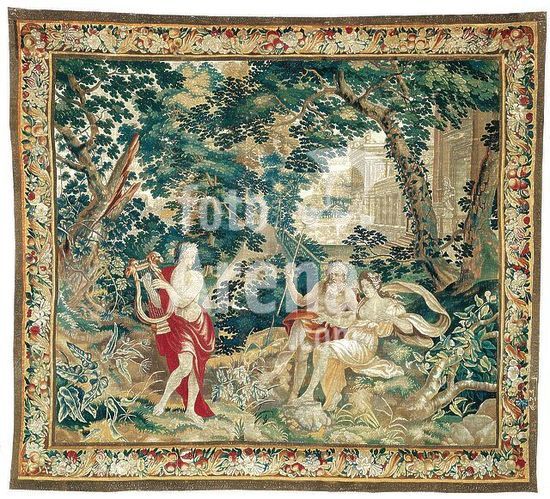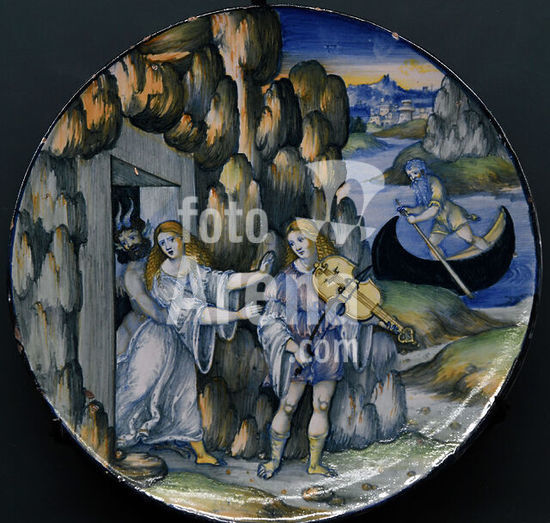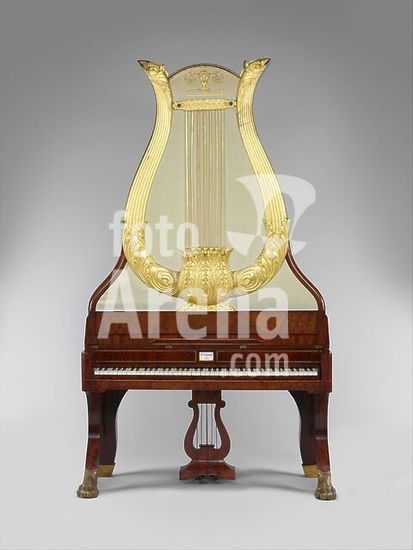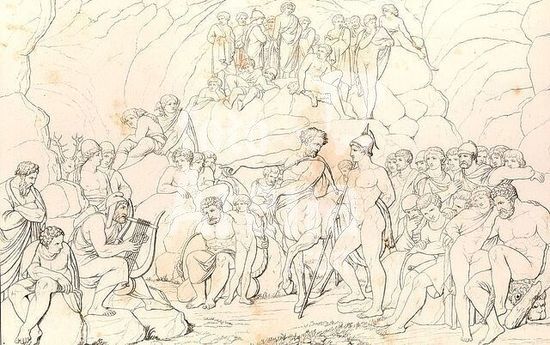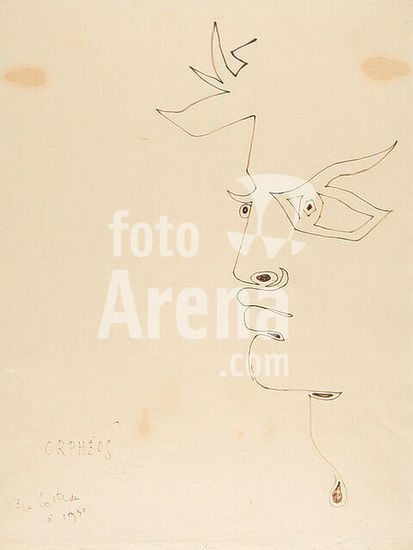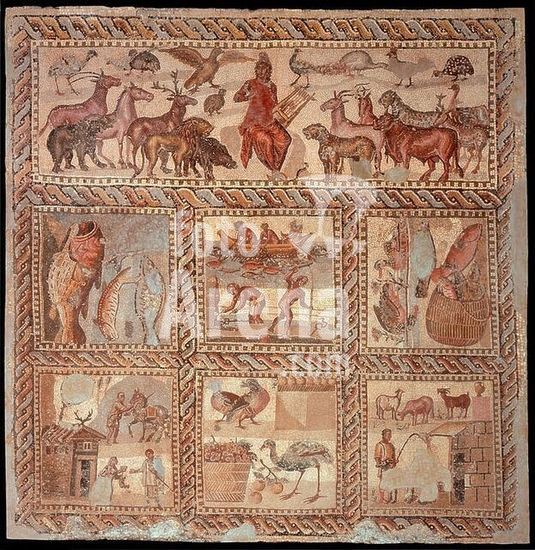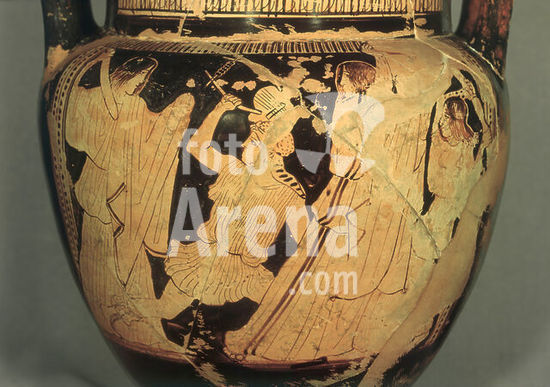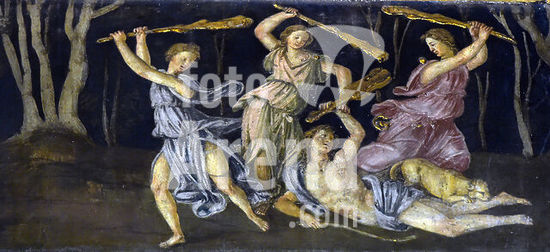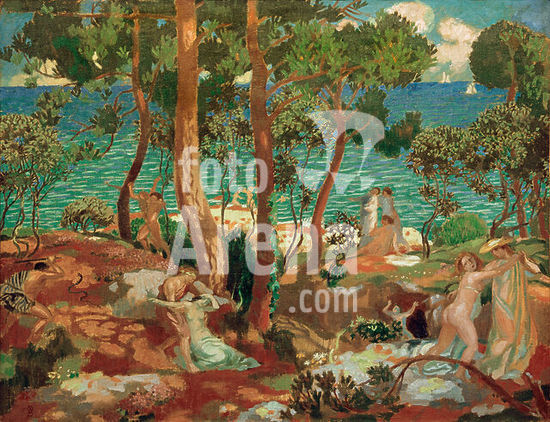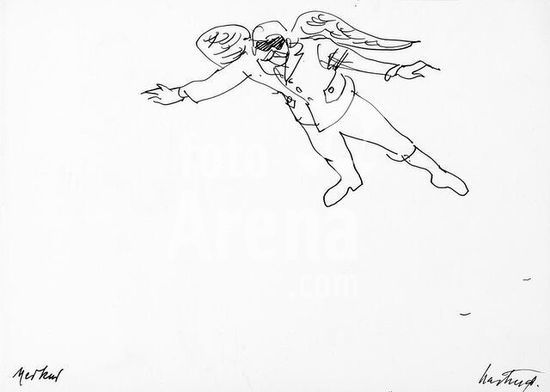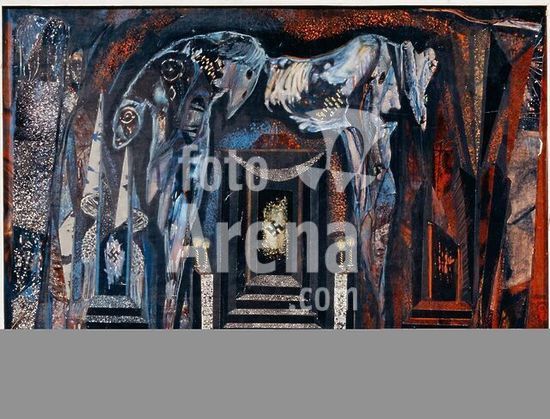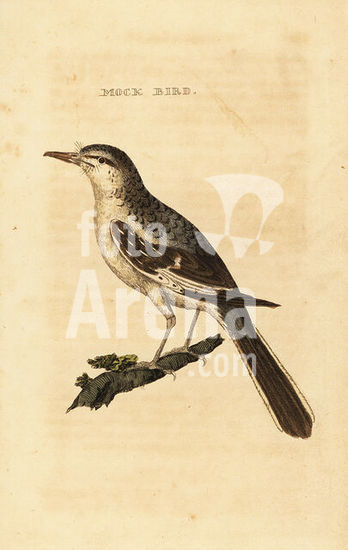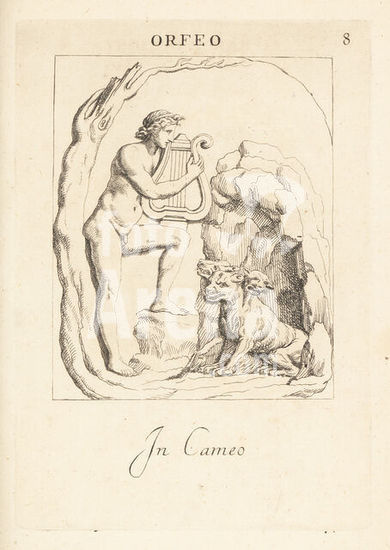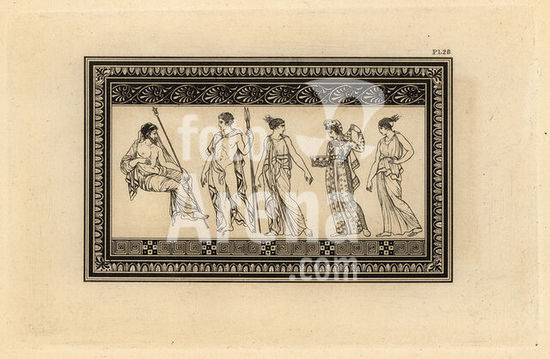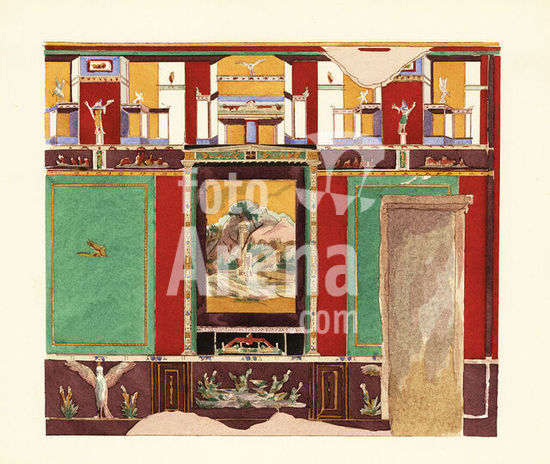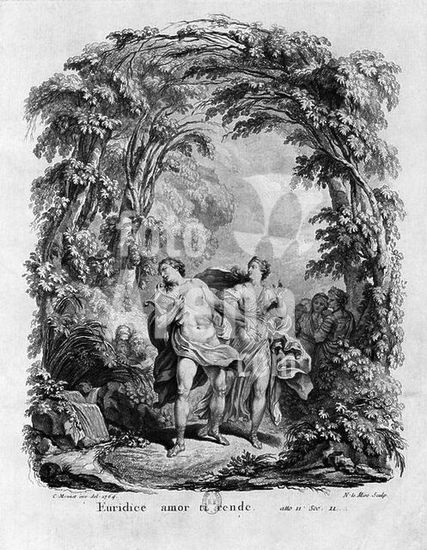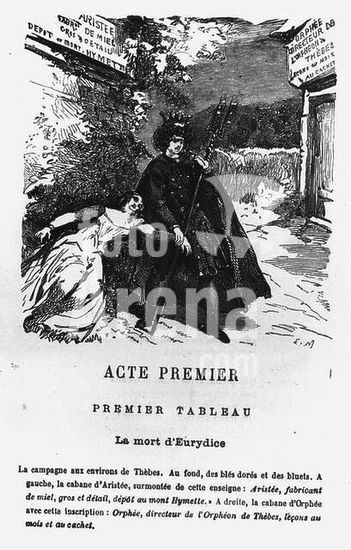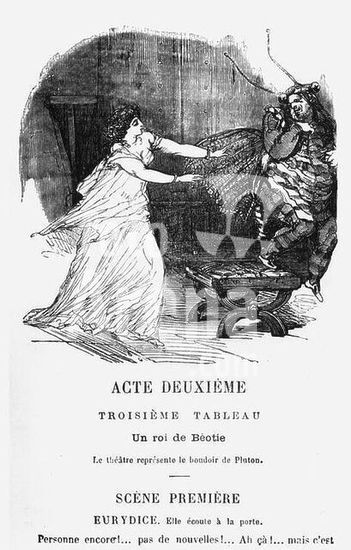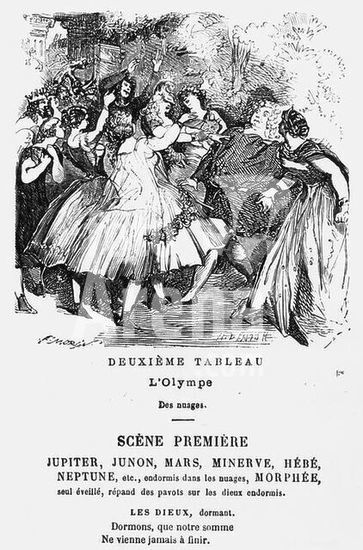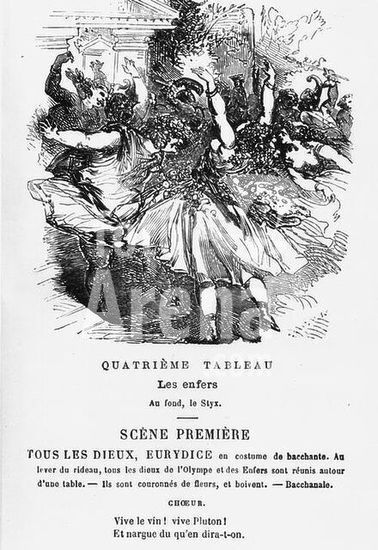
alb3623931
Barberini Cabinet. Artist and publisher: After woodcut illustrations by Francesco Del Tuppo (Italian, 1443/44-1501) , published in Naples in 1485. Culture: Italian, Florence. Dimensions: 23 1/4 x 38 1/8 x 14 1/8 in. (59.1 x 96.8 x 35.9 cm). Maker: Galleria dei Lavori, Florence. Date: ca. 1606-23."The Barberini family in the later sixteenth and seventeenth centuries presents a virtual paradigm of the well-managed Roman family. The Barberini recognized that the way to power and wealth lay through the Church and that the perpetuation of the family was dependent on marriage; and they accordingly consistently pursued both of those channels of family development. For several generations they were blessed with sufficient male offspring, and they managed this natural resource to the benefit of the family as a whole."[1] In line with this tradition, Maffeo (1568-1644), the second youngest of Antonio Barberini's six sons, left Florence in 1584, to take up residence and continue his education at the Collegio Romano in Rome as a protégé of his uncle Monsignor Francesco Barberini (1528-1600), the apostolic protonotary.[2] Maffeo later graduated from Pisa University as doctor of law. He returned to Rome in 1588-89 to embark on a meteoric ascent through the ecclesiastical hierarchy of the Vatican. From 1604 to 1607 he was accredited as papal nuncio to Henry IV's court in Paris, following an initial legation to France in 1602. This first Bourbon king (r. 1589-1610) had married Maria de' Medici (1573-1642), who came from Florence, the town where Maffeo was born and most of his family still lived. In the culturally stimulating environment of Paris, Maffeo acquired a refined taste for the arts and enjoyed many luxuries that had previously been beyond his reach. It may have been in Paris, too, that he redesigned the Barberini coat of arms for his own use, changing the wasps into bees and adding the sun symbol and laurel leaves of Apollo, patron of poets.[3] After his appointment to the Sacred College of Cardinals in 1606, he added a galero, the flat, red wide brimmed cardinal's hat adorned with scarlet tassels. These arms are set like a jewel in the center of the Museum cabinet's pediment. Three golden bees stand out against a lapis lazuli ground within a scrollwork cartouche that is embellished with stylized laurel sprigs and leaves and is surmounted by the galero. Probably because the panel is small, the galero is shown with six tassels on each side instead of the fifteen appropriate for a cardinal. Maffeo Barberini was elected pope on 6 August 1623 and took the name Urban VIII. Eager to immortalize his pontificate and to secure a place for his family among Europe's aristocracy, he became a great patron of the arts and named his brother and three of his nephews cardinals. This nepotism made the Barberini family rich beyond measure, and their building programs changed the appearance of Baroque Rome.[4] The Barberini bees and laurel leaves appear on many of Urban VIII's commissions, one of the most significant of which was the baldachin designed by Gianlorenzo Bernini (1598-1680) and built between 1624 and 1633 in Saint Peter's.[5]On the door of the central compartment of the Museum's cabinet Orpheus, the legendary Thracian poet, is seen playing a lira da braccio, an early type of viol, and charming various button-eyed animals and grotesque beasts with his music. Clare Vincent has noted that "this panel is flanked by six subjects of animal cunning or foolishness taken from woodcuts in Francisco Tuppo's Aesop's Fables (Naples, 1485). These include the greedy dog who drops his morsel while trying to gobble up the one reflected in the water-the reflection is cleverly achieved in reverse-painted rock crystal. Below are animals hunting and hunted, with a witty revenge of cocks on their hunter, a fox."[6] In comparison with the poetic Orpheus scene above, this merciless illustration - the cocks are carrying the dead beast home on a stick - bespeaks an awareness of sudden changes in which a pleasant life is turned "upside down" into tragedy. The panels to left and right of the door, in the top register, show the salamander, impervious to fire (fig. 13), and the phoenix, a bird that according to classical myth lived for centuries and then burned itself to ashes, from which a new, young phoenix arose. The salamander was an emblem of Francis I of France (1494-1547) - a celebrated patron of art and poetry such as Maffeo wished to be - and the phoenix was the device of Pope Clement VIII (1536-1605), who had granted Maffeo the position of nuncio at the French court.[7] This logical interpretation of the panels' symbolism has been questioned by Michael Bohr, who dated the cabinet much later, to about 1665-75;[8] it is difficult, however, to dismiss the revised Barberini coat of arms as evidence that the cabinet's first owner was the young Florentine who had been papal nuncio at the court of Henry IV. There is subtler evidence, too, that connects the cabinet with Maffeo. The phoenix, which symbolizes chastity and resurrection, looks up toward the sun that represents Apollo, the god who played for the Muses on Mount Parnassus as Orpheus played for the animals. Apollo is often represented with a crown of laurel in recognition of his achievements as patron of poetry and music.[9] As we have seen, both laurels and the Apollonian sun were added by Maffeo to his arms, the presence of which at the top of the cabinet reinforces the looser symbolism of the other plaques on this outstanding piece of furniture, which is clearly intended to glorify the owner as artist and as arbiter of the arts.Only the exact dating of the cabinet remains mysterious. In 1606, when Maffeo was made a cardinal, he could still be considered a "son of Florence." That the cabinet was a propaganda gift from the grand dukes of Tuscany, the family of Maria de' Medici, to Maffeo on that occasion is speculative but possible. Yet the subject matter of the panels suggests an intimate knowledge of Maffeo's ambitions, and it seems more likely that he commissioned the cabinet himself or that it was a present from his own family or friends in honor of his elevation to cardinal, or of some other auspicious event that occurred between 1606 and August 1623, when he adopted the papal coat of arms.[10]The pietre dure plaques reflect the high technical standard of the grand-ducal workshop in Florence, the Galleria dei Lavori.[11] Large panels with floral branches and colorful birds executed after designs possibly provided by Jacopo Ligozzi (1547-1626) decorate the cabinet's sides and-very unusually-the top. This suggests that the cabinet was originally supported on a low stand that would permit close viewing of the top from above. The stand was most likely a simple table draped with precious fabric. All the panels are framed by ripple moldings that are designed to catch the light, especially that of candles in a dark room.[12]The carcase construction of the cabinet and its ripple moldings relate it to a cabinet made for the Medici, now in the Palazzo Vecchio in Florence, dating to about 1615-20,[13] and to a cabinet in the National Gallery of Canada, Ottawa.[14] The technical perfection of the works seems to indicate that all three pieces were produced by German craftsmen settled in Florence. The employment of several German craftsmen at the Galleria is documented, as is the unusual fact that some of them owned their tools and lathes, which they may have brought with them from Germany.[15] Oak is rarely used in the construction of contemporary Florentine cabinets.[16] Nevertheless, we know that some foreign masters brought with them the materials they were accustomed to use and received reimbursement later. Given the sumptuousness of the other materials used on the Museum's cabinet, especially the exotic snakewood on the front between the drawers, the extra expense for oak to create a stable construction seems minor.[17]The Orpheus scene is based on an etching by Antonio Tempesta (1555-1630).[18] The theme appears also on the imitation damascened-iron fittings on Milanese furniture and on cast-bronze plaques.[19] The theme would become one of the Galleria's most popular products: no less than eighteen pieces of furniture, each with a slightly varied central Orpheus plaque and different animal panels, are documented.[20] This indicates that panels could be commissioned separately and then mounted later according to the taste of the individual patron. The most impressive examples are a show cabinet of 1660-70 in the collection of Juan March Ordinas at Palau March in Palma de Mallorca[21] and at the Château de Beloeil, Mons, Belgium, a pair of Sicilian cabinets with red coral mounts surrounding the pietre dure panels.[22] The Barberini cabinet seems to be by far the earliest and most elaborately conceived object of this extensive group depicting Orpheus charming the animals.[Wolfram Koeppe 2006]Footnotes:[1] Patricia Waddy. Seventeenth-Century Roman Palaces: Use and the Art of the Plan. New York, 1990, p. 128.[2] On the life and papacy of Maffeo Barberini, Pope Urban VIII, see The Dictionary of Art. Ed. Jane Turner. 34 vols. New York, 1996, vol. 3, pp. 205-7 (entry by John Beldon Scott); Sebastian Schütze, Kardinal Maffeo Barberini, später Papst Urban VIII., als Auftraggeber und Mäzen: Beiträge zu einer Archäologie des römischen Hochbarok. Römische Forschungen der Bibliotheca Hertziana 32. Munich, 2005 (I thank Olga Raggio for bringing this important reference to my attention); and Catholic Encyclopedia (online at www.newadvent.org/cathen/15218b.htm).[3] The Dictionary of Art. Ed. Jane Turner. 34 vols. New York, 1996, vol. 3, p. 205 (entry by John Beldon Scott).[4] Patricia Waddy. Seventeenth-Century Roman Palaces: Use and the Art of the Plan. New York, 1990, p. 130.[5] These four bronze spiral columns are covered with laurel branches. Several other works of art commissioned by the Barberini family in the pope's honor include this specific floral motif. Allegory of Divine Providence, a fresco by Pietro da Cortona (1596-1669) in the Palazzo Barberini ordered by Urban's nephew Cardinal Francesco Barberini, idealizes the pope's pontificate, his moral standards, and his political and especially his poetic skills. The center is dominated by the papal arms, three bees encircled by a laurel wreath. A putto nearby holds the laurel crown awarded to worthy poets. See The Dictionary of Art. Ed. Jane Turner. 34 vols. New York, 1996, vol. 3, pp. 206-7 (entry by John Beldon Scott).[6] The Metropolitan Museum of Art. Recent Acquisitions: A Selection, 1987-1988. New York, 1988, pp. 28-29 (entry by Clare Vincent). For the woodcuts, see Francesco Tuppo, ed. and trans. Aesopus: Vita e Fabulae. Naples, 1485. Repr.: Ed. Carlo Zucchetti. Milan, 1963, fabulae 2, 6, 18, 23, 35.[7] The Metropolitan Museum of Art. Recent Acquisitions: A Selection, 1987-1988. New York, 1988, p. 29 (entry by Clare Vincent); and Jack Freiburg, The Lateran in 1600: Christian Concord in Counter-Reformation Rome. Cambridge and New York, 1995. The salamander was also at this time an emblem of France. On the facade of San Luigi dei Francesi (the French church in Rome, completed 1589), the salamander guards the portals. On the left is the device of Francis I with his motto "Nutrisco et extingo" (I nourish and destroy), but on the right the salamander is surrounded by the legend "Erit Chri[s]tianorim lumen in igne" (The light of the Christians will be in the fire).[8] Michael Bohr. Die Entwicklung der Kabinettschräncke in Florenz. Europäische Hochschulschriften, ser. 38, Kunstgeschichte 182. Frankfurt am main, 1993, pp. 200-203, no. III.[9] James Hall. Dictionary of Subjects and Symbols in Art. Rev. ed. New York, 1979, p. 26.[10] Jacques Martin. Heraldry in the Vatican/L'araldica in Vaticano/Heraldik im Vatikan. Gerrards Cross, Buckinghamshire, England, 1987, pp. 133-36.[11] Anna Maria Giusti, Paolo Mazzoni, and Annapaula Pampaloni Martelli, Il Museo dell'Opificio delle Pietre Dure a Firenze. Gallerie e musei di Firenze. Milan, 1978; Umberto Baldini, Anna Maria Giusti, and Annapaula Pampaloni Martelli, eds. La Capella dei Principi e le pietre dure a Firenze. Gallerie e musei di Firenze, Milan, 1979; and Pierre Ramond. Chefs-d'oeuvre des marqueteurs. Vol. I, Des origines à Louis XIV. Dourdan, 1994, pp. 63-66.[12] For these moldings, see Josef Maria Greber. Die Geschichte des Hobels von der Steinzeit bis zum Entstehen der Holzwerkzeugfabriken im frühen 19. Jahrhundert. Zurich, 1956, pp. 335-38; and Wolfram Koeppe. Die Lemmers-Danforth-Sammlung Wetzlar: Europäische Wohnkultur aus Renaissance und Barock. Heidelberg, 1992, pp. 103-4, no. M38.[13] Umberto Baldini, Anna Maria Giusti, and Annapaula Pampaloni Martelli, eds. La Capella dei Principi e le pietre dure a Firenze. Gallerie e musei di Firenze, Milan, 1979, pp. 291-92, no. 101, pl. 143.[14] Acc. no. 28145[15] Michael Bohr. Die Entwicklung der Kabinettschräncke in Florenz. Europäische Hochschulschriften, ser. 38, Kunstgeschichte 182. Frankfurt am main, 1993, p. 16[16] Ibid., pp. 200-203, no. III.[17] Alvar González-Palacios. Mosaici e pietre dure: Firenze, paesi germanici, Madrid. I quaderni dell'antiquariato. Collana di arti decorative 21, year 2. Milan, 1982, p. 38; and Michael Bohr. Die Entwicklung der Kabinettschräncke in Florenz. Europäische Hochschulschriften, ser. 38, Kunstgeschichte 182. Frankfurt am main, 1993, pp. 311-12, doc. no. 317.[18] Sebastian Buffa, ed. Italian Masters of the Sixteenth Century: Antonio Tempesta. The Illustrated Bartsch 37. New York, 1984, p. 124.[19] Peter Hughes. The Wallace Collection: Catalogue of Furniture. 3 vols. London, 1996, vol. 1, p. 126, no. 21; and Christopher Wilk, ed. Western Furniture, 1350 to the Present Day, in the Victoria and Albert Museum, London. London, 1996, p. 62, figs. 1, 2 (entry by Tessa Murdoch).[20] Information in the archives of the Department of European Sculpture and Decorative Arts, Metropolitan Museum.[21] Juan José Junquera y Mato. Spanish Splendor: Great Palaces, Castles, and Country Houses. New York, 1992, p. 261. I was not able to examine the March cabinet personally for this study.[22] Jean Gismondi and Isabelle Richard. "Le Corail: Symbole antique, fétiche populaire et joyau baroque." In Les Antiquaires...au Grand Palais: XIVe Biennale Internationale, 22 september-9 octobre 1988, pp. 87-99. Paris, 1988, fig. 9. I am grateful to H.S.H. the prince de Ligne, Château de Beloeil, Belgium, for bringing this information to my attention. Museum: Metropolitan Museum of Art, New York, USA.
DC

